PULSATILLA GRANDIS
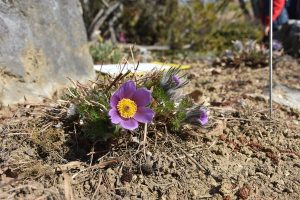
Anyone who has ever visited Poljčane couldn’t have overlooked the flourishing Boč mountain range, rising above the river Dravinja. The mountain dominates the space; gazes near and far are directed at it. Due to the exceptionally preserved natural and cultural heritage, the area surrounding Boč, together with Donačka gora, was declared the Boč-Donačka landscape park. It includes forests, dry and wet meadows, streams, springs, and areas with anthropogenic influences reflected in the cultural landscape and architecture.
Nature least affected by man in the municipality of Poljčane is carefully protected through nature reserves. They are subject to the strictest protection regimes, which ensure their preservation. In the area of Boč, protected within reserves is the forest area just below the top of the mountain and the primeval forest remnant between Boč and Plešivec.
A significant percentage of areas in the municipality of Poljčane are included in Natura 2000 sites – areas extremely important for the conservation of biodiversity at the European level. In our municipality, areas Boč-Haloze-Donačka gora, the Dravinja valley, and Ličenca near Poljčane are considered essential for the conservation of European important species
But Natura 2000 sites alone do not contribute to the preservation of biodiversity. Slovenia has also declared ecologically critical areas, to protect species and habitat types rare or endangered at the Slovenian level. In this, they differ from Natura 2000 sites. Such areas in the municipality of Poljčane are the ones mentioned above and the area pf Ljubična-Zgornje Poljčane, where the rare and endangered steppe beauty velikonočnica grows on the dry meadows of Boč.
This delicate steppe plant, growing in an isolated area, is a symbol of Boč and adorns the coat of arms of the Municipality of Poljčane.
Velikonočnica spread from the north to these regions during the Ice Age. After the cold withdrew, smaller populations of this northern European flora, in generally higher altitudes, were preserved.
It is a perennial that grows on calcium-rich soil in dry meadows, rocky outcrops as well as pine and oak forests. It blooms from February to April, during Easter (velika noč), which gave it its name. Its stem is protected from the cold with velvet hairs, so it can also be called ‘veliki kosmatinec’ (big furry).
It is more common in Eastern Europe but also thrives in Central Europe. It’s a rare representative of steppe plants in Slovenia and is increasingly endangered, as it grows mostly in the wider area of Boč and near Šentjurje. As such, it’s an endemic species.
The most famous site is on Boč. Unfortunately, it was already exterminated above the hut, as well as on the remaining meadows. It remained only on the hill, where it still thrives today, but in a small population, which is no longer self-sustaining, as there are too few specimens left. Few specimens also remained at the site in Zgornje Poljčane. The well-known population from Boč is a victim of excessive popularization, charisma, and unfortunately inappropriate ideas and solutions for its protection.
Boč is a mountain in the Boč-Donačka gora landscape park, dominating the landscape between Sotla and Dravinja with its 979 meters above sea level.
At the top is a 20-meter-high steel communication tower, with a television transmitter nearby. Below the top is a mountain lodge you can get to with an asphalt road from Zgornje Poljčane. A road from Studenice leads to the transmitter. From Poljčane it is possible to climb the mountain with the forest educational trail also known as ‘Detičkova pot’ or along the path across Baba, a limestone lookout pier, offering a beautiful view of Poljčane and the Dravinja valley.
The Boč area consists of various peaks, ridges, slopes, and small plains, without any noteworthy watercourses, as the world is predominantly karst, and the waters sink underground. They come to the surface as karst springs, which are, along with caves, sinkholes, gullies, and cliffs, the karst phenomena classifying the Boč area and its surroundings as isolated karst.
Rocks like limestone and dolomite can be found here and on the sunny side of the mountain, healing mineral water boils, which has led to the development of the Rogaška Slatina health resort.
Sara Pahole, Class 8 b
Detection of PTEs (potentially toxic elements) and some other pollutants in the river Dravinja and the stream Brežnica in Poljčane
Seventh graders continued with chemical analysis of local surface waters. The study aimed to determine whether toxic elements such as manganese, copper, nickel, zinc, cadmium, arsenic, lead, iron, and some pollutants (ammonium, nitrate, detergents, and phenols) are present in water. They also measured the pH of the water and determined the color, turbidity, and odor of individual water samples.
Marina Koražija
We planted a traditional Slovenian wildflower hay meadow
Students of our school creatively participate in the Erasmus+ project Love sustainable society. The Miyawaki forest grows, the fence protects it, and students water the plants diligently. Recently we have added a traditional Slovenian wildflower meadow. It will enrich our lives, and attract bees and other pollinators.
Orchards, full of fruit and also of birds, traditional meadows, swamps, and amphibians are a few pieces of nature that we need to protect and preserve.
The meadows that grow on the other side of the Brežnica stream and along the Dravinja river are intensive, with very few different sorts of plants and animals.
A few decades ago, wildflower hay meadows grew here. Traditional mowing and forage harvesting predominated. Livestock grazed on such meadows, there were no artificial fertilizers, no drying out.
But such meadows are not profitable enough in modern times. It takes a lot of time to produce hay traditionally. Therefore, unfortunately, they are disappearing from the Slovenian and European space.
But why are they so important? They are a natural seed bank. They preserve the diversity of meadow plants, landscapes, and natural heritage. We need traditional meadows to relax and to enjoy looking at the colorful meadow carpet, too.
Marina Koražija, Tatjana Zgubič
We love working with wood
Give me a qualitative and interesting task and I will be happy to do it! Students Gal Šket, Martin Peršoh and Žiga Lužar, all from class 8 b, Miha Onič Fabjan from class 8 a, Matic Klančnik Sobotič, Leja Pauman and Ajda Založnik Kodrič from class 9 b.
They cooperated on a project during the winter holidays. They renovated wooden chairs for the Poljčane Mountain Lodge and so they did an outstanding job at the initiative and under the expert guidance of teacher Sabina Kralj. They restored 20 chairs.
They did something good for all of us.
Thank you, boys and girls, you were great! You acted like a real team and we are proud of you. You are a true example of how we can breathe new life into wooden furniture which looks worn out. Your project contributed to sustainability. You enjoyed working in a team and re-emphasized the fact that wood is a healthy, beautiful, and renewable material.
School principal Francka Mravlje, mag.
A fence around the Miyawaki forest
The fence around the mini forest stands firm! It protects the young plants which have already started with the spring growth. We will be watching how the leaves on shrubs and young trees sprout in the next few weeks!
We will take care of young plants in this fast-growing, sustainable, and urban forest throughout the year. Last week, we made sure that the fence remains strong. Third-graders and seventh-graders coated the top of the fence posts with grafting putty. The grafting putty is used for wounds on the trees, but in our case, it will protect the poles from rotting.
Nothing is possible without hard hardworking students. There is a group of Miyawaki forest guardians. The plants will be protected from weeds, pests, we will monitor their growth. Above all, we will monitor which animals will choose a mini urban forest to stop by or even build a new home here. Biodiversity boosts ecosystem productivity where each species, no matter how small, has an important role to play. Think of noise reduction, cleaner air, the amount of oxygen, the wind that will get caught in the branches of trees!
Marina Koražija
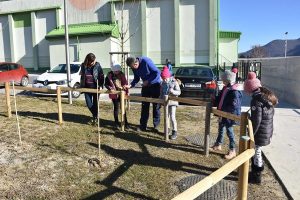
GOOGLE MEET OF FOUR PARTNER SCHOOLS
DECEMBER 8, AT 14.30 CET
Students and teachers talked about the dissemination of the project, activities that were finished in October and November at each school, and plans for the future.
Each school invited one, two, or more students to the event. Students were part of the meeting and they talked about the Erasmus+ activities at schools. Students joined from their homes or from their classrooms. English teachers and project coordinators helped students and give them some basic guidelines on how to present topics related to sustainability.
Students were highly motivated and their presentations were interesting and full of interesting facts.
Being in the project increases learning opportunities, students are confronted with problems, they find themselves in different situations, they get more experience.
Thank you to all students in the Google Meet. You nailed it!
TRADITIONAL SLOVENIAN BREAKFAST
The nationwide campaign goes 13 years back when the Slovenian Beekeepers’ Association launched a project to encourage schools to serve local honey for breakfast. Over the years, the “honey breakfast” project has evolved into Slovenian Food Day promoting locally produced food and the benefits of eating breakfast.
Slovenians know that healthy, locally-produced food is important for living a long and healthy life, and the Traditional Slovenian Breakfast campaign promotes all these benefits for schoolchildren all over the country.
At the Elementary School Kajetan Kovič Poljčane all students from the first to the ninth grade eat locally produced apples, bread, and honey, and they drink fresh milk from the local farm.
Nejc Zidarič
Dear eTwinning partners,
Every year is like a miracle: it brings new hope, new ideas, new ways to reach goals. It brings us consolation that life always finds a new path whatsoever happens. Therefore, let us accept the year which is coming with joy and love.
May the year 2022 be good, kind, and successful to all of you. Practice gratitude, hug your friends and family and don’t wait to live your best life. Because we have it now and here.
Blessings, love, and peace to you this Christmas!
Students and teachers of the Elementary School Kajetan Kovič Poljčane
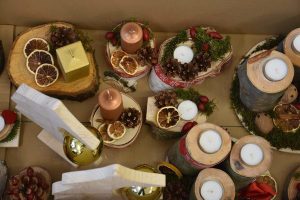
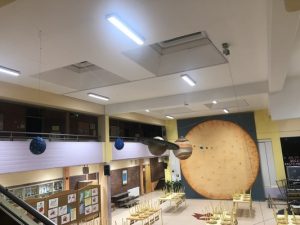
In the school hall, you could see a model of the solar system, which was made by the students who are part of the Eco-School, Globe Project, Erasmus +, and POGUM.
Students made some researches about the Solar System, prepared materials, and with the teachers’ and janitor’s help started their work. To make it easier to imagine the dimensions of the planets and the sun, we made the sizes of the models in the right proportions. We have reduced them by more than 100-million times. Their mutual distance is symbolic, as they should be much further away from the Sun. At this size, as shown, the Earth should be 1 km away from the Sun and the last planet Neptune 32 km away.
We added information about our solar system on the billboards and a Foucault pendulum which is proof that our planet Earth rotates as the pendulum changes its direction during oscillation.
Of all the planets, our Earth bursts with life. Earth Day is celebrated on April 22nd. The planet we live on is unique and unrepeatable, so let’s do something good for it every day!
Marina Koražija
HONEY PLANTS IN THE SCHOOL GARDEN
3rd, 7th, and 8th graders planted honey plants next to the insect hotel in the school playground. We know bees are hard at work if they find honey plants. They gather nectar and pollen for hives and they also spread pollen from plant to plant. The color and scent of flowers attract bees and other insects. When a bee lands on a flower, pollen sticks to the hairs of its body. When a bee flies to the next flower, the pollen sticks to the flower cells. This process is called pollination. Without pollination, new plants or flowers could not grow. Meanwhile, the nectar a bee sucks up with its tongue is used for making honey. A bee delivers that nectar to the hive. Then it flies right back out to get more.
By planting honey plants we create a new ecosystem that sustainably enriches the diversity of the school garden. We will observe plants and understand the connections and influences of various environmental factors on plants. We will be aware of the importance of climate changes in living and non-living nature, learn about new plants and their life cycles.
In the spring we will grow sunflowers from seeds. Sunflowers are an excellent choice to experience a full cycle of starting something from seed, seeing it grow almost in front of our eyes, and harvesting our own sustainable seeds for planting the following year.
Marina Koražija
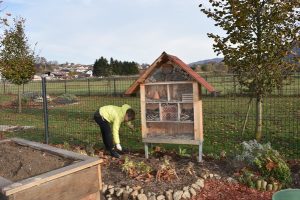
The Miyawaki forest
We have finally planted the Miyawaki forest!
What do you envision when you think of a forest? You probably imagine a land covered with trees. In many countries, traditional forests are being destroyed. Tiny forests have sprung up in cities around the world. They’re increasing biodiversity and fighting climate change.
These mini forests are inspired by Akira Miyawaki. He’s a botanist, or plant scientist, from Japan who pioneered a unique way of growing forests. It’s known as the Miyawaki method. It involves planting a wide variety of native trees close together and leaving them to grow into a dense forest
The Miyawaki method is said to grow trees 10 times faster than other methods. And these tiny forests are more biodiverse than traditional forests. The diversity of tree species attracts a greater variety of insects and amphibians looking for food and shelter.
The Miyawaki method has become popular in Europe. Love Sustainable Society team members of four schools from three countries have decided to plant Miyawaki forests.
The schools in Vilnius, in Užice, and in Makole have already planted their mini forests. On November 2021 students of Elementary school Kajetan Kovič and a team of professional botanists planted the first Miyawaki forest in Poljčane, too.
Nejc Zidarič
The school sustainable garden is richer for the starflower
The flowers of borage or starflower contain a lot of nectar, so bees and other pollinators like to fly around them. It blooms from May to November. Young leaves and flowers can be used for salads, risottos, soups, spreads, yogurt. For tea leaves or flowers can be used. We can pour them with boiling water and leave standing for a few minutes.
We planted borage in the school garden near the insect hotel. The members of the Erasmus+ club said hello to the school plane tree, measured the thickness of its trunk (it takes three students to hug it), played in nature, and took care of a lost caterpillar.
Marina Koražija

